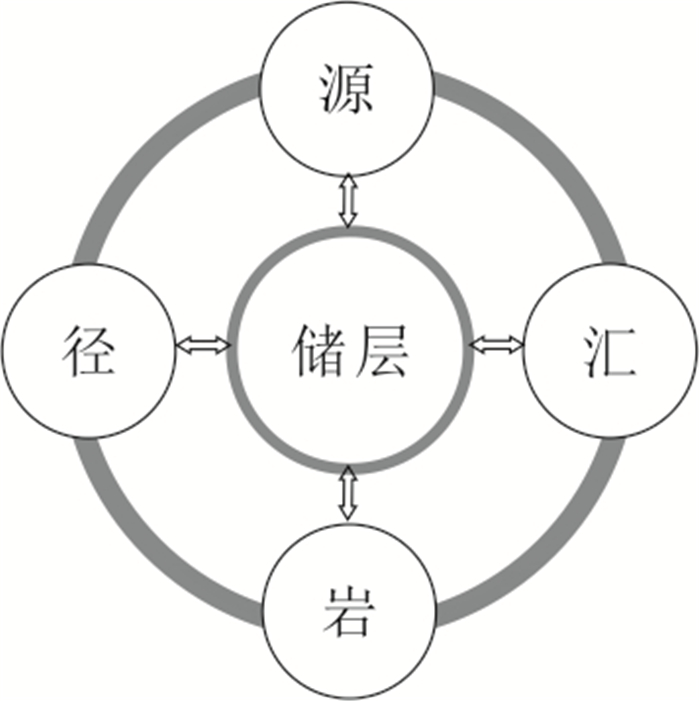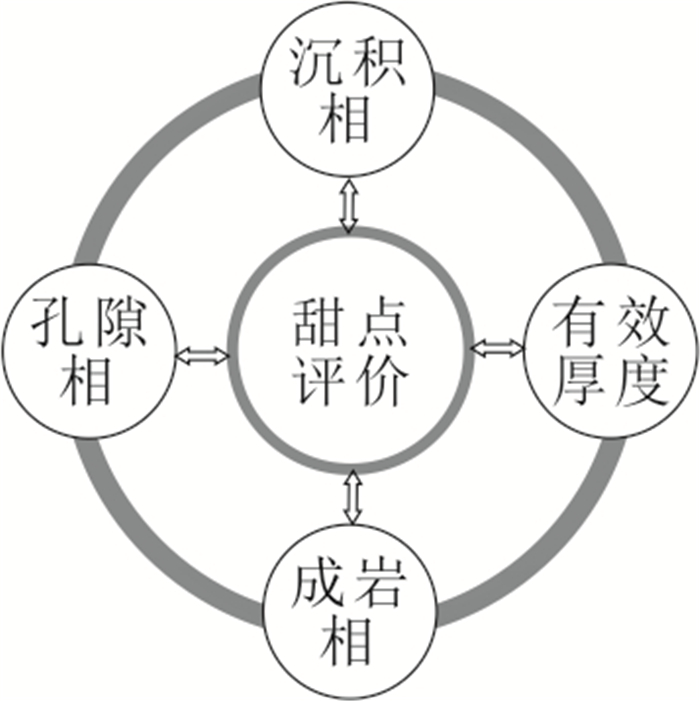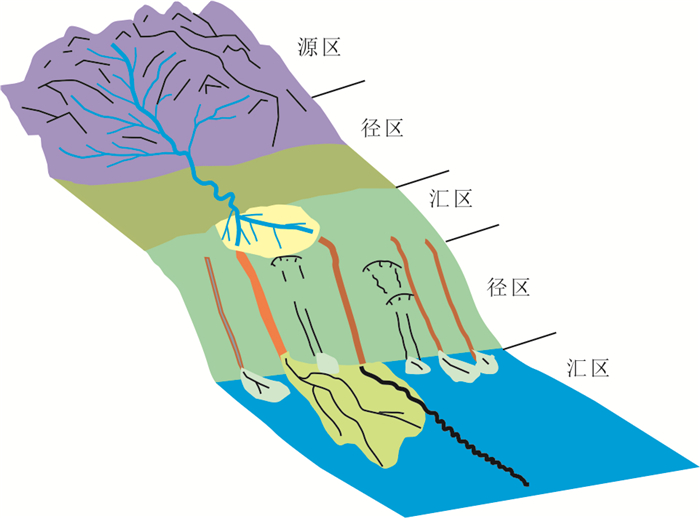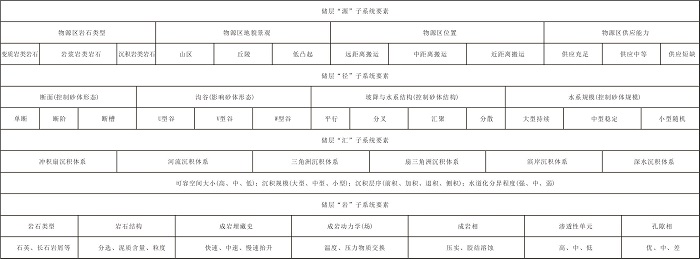Method and Application of Reservoir "Source-Route-Sink-Rock" System Analysis
-
摘要: 复杂油气储层非均质性强、“甜点”成因控制因素复杂,面对精细表征与预测要求,储层研究需要在研究思路与方法体系上有所改进.基于盆地沉积学发展起来的“源-汇”系统分析为复杂储层系统研究提供了新思路.经过多年实践,本文提出了储层系统研究的“源-径-汇-岩”(source-route-sink-rock,SRSR)系统分析思路与方法,强调开展基于沉积物(岩)的四个子系统研究,即“源——沉积物物质组成与来源”、“径——沉积物搬运过程与路径”、“汇——沉积物汇聚堆积环境与变化”、“岩——沉积物埋藏成岩过程与成岩相”.介绍了各个子系统要素构成,认为四个子系统共同决定宏观和微观非均质性,共同决定储层质量.在源汇分区、沉积相分区及成岩相分区基础上,用甜度RSI指标划分区域储层“甜点”等级,并在乌石凹陷低渗储层评价中加以应用,取得良好效果.储层SRSR系统分析是复杂“甜点”储层成因研究的新思路,是复杂非均质储层精细表征的技术遵循,为开展复杂常规储层、致密储层、非常规泥页岩储层定量化评价预测提供了新的理论和方法支持.Abstract: Complex oil and gas reservoirs have strong heterogeneity and complex "sweet spot" genetic control factors. Faced with the requirements of fine characterization and prediction, reservoir research needs to be improved from the research ideas and method system. The "source-sink" (S2S) system analysis developed based on basin sedimentology provides new ideas for the study of complex reservoir systems. In this paper, it further proposes the "source-route-sink-rock" (SRSR) system analysis ideas and methods, emphasizing the development of four sub-systems: "source-sediment material composition and source", "route-sediment transport process and path", "sink-sediment convergence accumulation environment and change", and "rock-sediment burial diagenetic process and diagenetic facies". The element composition of each subsystem in the reservoir research system is preliminarily established in this paper. The four subsystems jointly determine the macro and micro heterogeneity attributes and jointly determine the reservoir quality. Based on the source-sink division, sedimentary facies division and diagenetic facies division, we used the sweetness RSI index to classify regional reservoir "sweet spots" and applied it in the evaluation of low-permeability reservoirs in Wushi Depression, and achieved good results. Reservoir SRSR system analysis is a novel idea to the study of the genesis of complex "sweet spot" reservoirs, and it is the technology to follow for the fine characterization of complex heterogeneous reservoirs. It provides new theoretical and methodological support for quantitative evaluation and prediction of complex conventional reservoir, tight reservoir and unconventional shale reservoir.
-
图 3 从陆地到海洋全流域“源-径-汇”系统地貌图
据Sømme et al.(2009)和林畅松等(2015)改编
Fig. 3. Schematic map showing the distribution of regional geomorphologic units in the "source-route-sink" system from the continent to ocean basin
图 5 玛曲段黄河干流及支流河型变化
据百度地图,https://map.baidu.com/@11368525.64,3997524.09,13z/maptype%3DB_SATELLITE_MAP
Fig. 5. The variations of the main stream and tributary of the Yellow River
图 6 南美Altiplano高原河流“径”子系统随时间、空间变化
据Li et al.(2014). C1为1975年,C2为1985年,C3为1987年,C4为1994年,C5为1997年
Fig. 6. Reconstruction of the abandoned channel Routes subsystem of Altiplano Plateau in South America
表 1 乌石凹陷储层甜点类型分级特征
Table 1. The classification characteristics of reservoir sweet spot types in Wushi Depression
储层甜点类型 储层甜点指数 主要孔隙相类型 孔隙度(%) 渗透率(10-3 μm2) FZI Ⅰ类 RSI > 300 A类,B类 16.07~16.17(16.12) 80.71~96.52(88.62) 2.12~8.83(4.59) Ⅱ类 200 < RSI < 300 B类 13.60~15.70(14.80) 27.91~68.49(47.27) 1.15~2.58(1.89) Ⅲ类 100 < RSI < 200 B类, C类 11.10~15.50(13.60) 7.60~33.09(20.00) 0.81~2.41(1.24) Ⅳ类 50 < RSI < 100 C类,D+E类 8.51~11.82(10.23) 0.47~8.18(3.49) 0.21~0.88(0.47) Ⅴ类 RSI < 50 D+E类,F类 8.51~9.49(9.07) 0.47~1.18(0.83) 0.21~0.68(0.37) 注:孔隙度、渗透率和FZI的数值表达为:最小值-最大值(平均值). -
Allen, P., 2005. Striking a Chord. Nature, 434(7036): 961. doi: 10.1038/434961a Allen, P. A., 2008a. From Landscapes into Geological History. Nature, 451(7176): 274-276. https://doi.org/10.1038/nature06586 Allen, P. A., 2008b. Time Scales of Tectonic Landscapes and Their Sediment Routing Systems. Geological Society, London, Special Publications, 296(1): 7-28. https://doi.org/10.1144/sp296.2 Allen, P.A., 2017. Sediment Routing Systems-The Fate of Sediment from Source to Sink. Cambridge University Press, Cambridge. Gao, S., 2005. Comments on the "NSF Margins Program Science Plans 2004". Marine Geology & Quaternary Geology, 25(1): 119-123 (in Chinese with English abstract). http://en.cnki.com.cn/Article_en/CJFDTOTAL-HYDZ20050100K.htm Garzanti, E., 2016. From Static to Dynamic Provenance Analysis-Sedimentary Petrology Upgraded. Sedimentary Geology, 336: 3-13. https://doi.org/10.1016/j.sedgeo.2015.07.010 Garzanti, E., Andò, S., Padoan, M., et al., 2015. The Modern Nile Sediment System: Processes and Products. Quaternary Science Reviews, 130: 9-56. https://doi.org/10.1016/j.quascirev.2015.07.011 Jia, C.Z., Zou, C.N., Li, J.Z., et al., 2012. Assessment Criteria, Main Types, Basic Features and Resource Prospects of the Tight Oil in China. Acta Petrolei Sinica, 33(3): 343-350 (in Chinese with English abstract). http://www.researchgate.net/publication/283961853_Assessment_criteria_main_types_basic_features_and_resource_prospects_of_the_tight_oil_in_China Jiang, P., Wang, Z.Z., Zou, M.S., et al., 2021. Development Characteristics of Carbonate Cement and Its Influence on Reservoir Quality in Sandstones from Zhuhai Formation in Wenchang A Depression. Earth Science, 46(2): 600-620 (in Chinese with English abstract). Kuzyk, Z. Z. A., Goñi, M. A., Stern, G. A., et al., 2008. Sources, Pathways and Sinks of Particulate Organic Matter in Hudson Bay: Evidence from Lignin Distributions. Marine Chemistry, 112(3-4): 215-229. https://doi.org/10.1016/j.marchem.2008.08.001 Li, J. G., Donselaar, M. E., Hosseini Aria, S. E., et al., 2014. Landsat Imagery-Based Visualization of the Geomorphological Development at the Terminus of a Dryland River System. Quaternary International, 352: 100-110. https://doi.org/10.1016/j.quaint.2014.06.041 Li, Z., Liu, J.Q., 2009. Key Problems and Research Trend of Diagenetic Geodynamic Mechanism and Spatio-Temporal Distribution in Sedimentary Basins. Acta Sedimentologica Sinica, 27(5): 837-848 (in Chinese with English abstract). http://en.cnki.com.cn/Article_en/CJFDTOTAL-CJXB200905009.htm Lin, C.S., Xia, Q.L., Shi, H.S., et al., 2015. Geomorphological Evolution, Source to Sink System and Basin Analysis. Earth Science Frontiers, 22(1): 9-20 (in Chinese with English abstract). http://www.researchgate.net/publication/281751373_Geomorphological_evolution_source_to_sink_system_and_basin_analysis Pang, X., Peng, D.J., Chen, C.M., et al., 2007. Three Hierarchies "Source-Conduit-Sink" Coupling Analysis of the Pearl River Deep-Water Fan System. Acta Geologica Sinica, 81(6): 857-864 (in Chinese with English abstract). http://www.researchgate.net/publication/291751019_Three_hierarchies_source-conduit-sink_coupling_analysis_of_the_Pearl_River_Deep-water_Fan_System?ev=auth_pub Pulliam, H. R., 1988. Sources, Sinks, and Population Regulation. The American Naturalist, 132(5): 652-661. https://doi.org/10.1086/284880 Shanmugam, G., 2016. Submarine Fans: A Critical Retrospective (1950-2015). Journal of Palaeogeography, 5(2): 110-184. https://doi.org/10.1016/j.jop.2015.08.011 Sømme, T.O., Helland-Hansen, W., Martinsen, O.J., et al., 2009. Relationships between Morphological and Sedimentological Parameters in Source-to-Sink Systems: A Basis for Predicting Semi-Quantitative Characteristics in Subsurface Systems. Basin Research, 21(4): 361-387. https://doi.org/10.1111/j.1365-2117.2009.00397.x Xu, C.G., 2013. Controlling Sand Principle of Source-Sink Coupling in Time and Space in Continental Rift Basins: Basic Idea, Conceptual Systems and Controlling Sand Models. China Offshore Oil and Gas, 25(4): 1-11, 21(in Chinese with English abstract). http://d.wanfangdata.com.cn/Periodical_zghsyq-gc201304001.aspx Xu, C.G., Du, X.F., Xu, W., et al., 2017. New Advances of the "Source-to-Sink" System Research in Sedimentary Basin. Oil & Gas Geology, 38(1): 1-11 (in Chinese with English abstract). http://en.cnki.com.cn/Article_en/CJFDTOTAL-SYYT201701002.htm Xue, Y.A., Pang, X.J., Hao, Y.W., et al., 2020. Genesis of High-Quality Mixed Rock Reservoir and Its Exploration Significance in Es1 around Southeast Margin of Qinnan Sag, Bohai Sea. Earth Science, 45(10): 3527-3542 (in Chinese with English abstract). Yao, G.Q., Sun, Y.C., Li, S.T., 1999. A Research System of Oil/Gas Reservoir Geology. Petroleum Exploration and Development, 26(1): 74-77 (in Chinese with English abstract). http://en.cnki.com.cn/Article_en/CJFDTOTAL-SKYK901.023.htm Zhu, H.T., Xu, C.G., Zhu, X.M., et al., 2017. Advances of the Source-to-Sink Units and Coupling Model Research in Continental Basin. Earth Science, 42(11): 1851-1870 (in Chinese with English abstract). http://en.cnki.com.cn/Article_en/CJFDTOTAL-SYYT201701002.htm Zhu, R.K., Zou, C.N., Yuan, X.J., et al., 2017. Research Progress and Development Strategic Thinking on Energy Sedimentology. Acta Sedimentologica Sinica, 35(5): 1004-1015 (in Chinese with English abstract). http://en.cnki.com.cn/Article_en/CJFDTOTAL-CJXB201705012.htm Zou, C.N., Tao, S.Z., Zhou, H., et al., 2008. Genesis, Classification and Evaluation Method of Diagenetic Facies. Petroleum Exploration and Development, 35(5): 526-540 (in Chinese with English abstract) doi: 10.1016/S1876-3804(09)60086-0 Zou, C.N., Yang, Z., Zhang, G.S., et al., 2019. Establishment and Practice of Unconventional Oil and Gas Geology. Acta Geologica Sinica, 93(1): 12-23 (in Chinese with English abstract). doi: 10.1111/1755-6724.13759 Zou, C. N., Yang, Z., Zhu, R. K., et al., 2019. Geologic Significance and Optimization Technique of Sweet Spots in Unconventional Shale Systems. Journal of Asian Earth Sciences, 178: 3-19. https://doi.org/10.1016/j.jseaes.2018.07.005 高抒, 2005. 美国《洋陆边缘科学计划2004》述评. 海洋地质与第四纪地质, 25(1): 119-123. https://www.cnki.com.cn/Article/CJFDTOTAL-HYDZ20050100K.htm 贾承造, 邹才能, 李建忠, 等, 2012. 中国致密油评价标准、主要类型、基本特征及资源前景. 石油学报, 33(3): 343-350. https://www.cnki.com.cn/Article/CJFDTOTAL-SYXB201203000.htm 姜平, 王珍珍, 邹明生, 等, 2021. 文昌A凹陷珠海组砂岩碳酸盐胶结物发育特征及其对储层质量的影响. 地球科学, 46(2): 600-620. doi: 10.3799/dqkx.2020.075 李忠, 刘嘉庆, 2009. 沉积盆地成岩作用的动力机制与时空分布研究若干问题及趋向. 沉积学报, 27(5): 837-848. https://www.cnki.com.cn/Article/CJFDTOTAL-CJXB200905009.htm 林畅松, 夏庆龙, 施和生, 等, 2015. 地貌演化、源-汇过程与盆地分析. 地学前缘, 22(1): 9-20. https://www.cnki.com.cn/Article/CJFDTOTAL-DXQY201501003.htm 庞雄, 彭大钧, 陈长民, 等, 2007. 三级"源-渠-汇"耦合研究珠江深水扇系统. 地质学报, 81(6): 857-864. doi: 10.3321/j.issn:0001-5717.2007.06.016 徐长贵, 2013. 陆相断陷盆地源-汇时空耦合控砂原理: 基本思想、概念体系及控砂模式. 中国海上油气, 25(4): 1-11, 21. https://www.cnki.com.cn/Article/CJFDTOTAL-ZHSD201304002.htm 徐长贵, 杜晓峰, 徐伟, 等, 2017. 沉积盆地"源-汇"系统研究新进展. 石油与天然气地质, 38(1): 1-11. https://www.cnki.com.cn/Article/CJFDTOTAL-SYYT201701002.htm 薛永安, 庞小军, 郝轶伟, 等, 2020. 渤海海域秦南凹陷东南缘沙一段混积岩优质储层成因及勘探意义. 地球科学, 45(10): 3527-3542. doi: 10.3799/dqkx.2020.154 姚光庆, 孙永传, 李思田, 1999. 油气储集层地质学研究体系. 石油勘探与开发, 26(1): 74-77. https://www.cnki.com.cn/Article/CJFDTOTAL-SKYK901.023.htm 朱红涛, 徐长贵, 朱筱敏, 等, 2017. 陆相盆地源-汇系统要素耦合研究进展. 地球科学, 42(11): 1851-1870. doi: 10.3799/dqkx.2017.117 朱如凯, 邹才能, 袁选俊, 等, 2017. 中国能源沉积学研究进展与发展战略思考. 沉积学报, 35(5): 1004-1015. https://www.cnki.com.cn/Article/CJFDTOTAL-CJXB201705012.htm 邹才能, 陶士振, 周慧, 等, 2008. 成岩相的形成、分类与定量评价方法. 石油勘探与开发, 35(5): 526-540. https://www.cnki.com.cn/Article/CJFDTOTAL-SKYK200805004.htm 邹才能, 杨智, 张国生, 等, 2019. 非常规油气地质学建立及实践. 地质学报, 93(1): 12-23. https://www.cnki.com.cn/Article/CJFDTOTAL-DZXE201901003.htm -










 下载:
下载:









